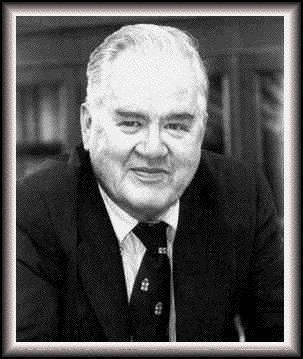

John Tukey
As a chemist-turned-topologist-turned statistician, John Wilder Tukey played a key role in the development and study of statistics in the mid 1900's. The field of statistics has benefited tremendously from his contributions.
J. W. Tukey was born on July 16, 1915, in New Bedford, Massachusetts. He was the only child of Ralph H. and Adah M. (Tasker) Tukey. His parents recognized the great potential in their son at a very early age and decided to school him at home. Home schooling was convenient for Tukey since both of his parents were teachers. Tukey's formal education did not begin until he entered Brown University in Providence, Rhode Island, to study mathematics and chemistry.
Tukey complete his studies at Brown University when he graduated with a Master's degree in chemistry. He then went on to study for a doctorate in mathematics at Princeton University in 1937. Tukey received his doctorate in 1939 for the dissertation Denumerability in topology. This impressive thesis was then published in 1940 as Convergence and Uniformity in topology. It was the second book in the Annals of Mathematics Studies of the Princeton University Press. However, this was not Tukey's first publication. Even prior to obtaining his doctorate, he wrote three papers that had been published.
After receiving his doctorate, Tukey accepted an offer to become an instructor at Princeton University. At this time, his work was mainly concentrated in the area of abstract mathematics. Also at this time, World War II was becoming a great influence on people's, including Tukey's, lives. In hopes of contributing to the war efforts, Tukey then joined the Fire Control Research Office directed by Merrill Flood. Many of the group's studies of weapons involved statistical problems. Tukey found he really enjoyed this type of mathematics.
During this time, Tukey had the opportunity to work with many other great statisticians. He worked with George W. Brown, who had just completed a doctorate in Statistics in the department of mathematics at Princeton, Charles P. Winsor, a biostatiscian from Iowa State, Wilfrid Dixon of Princeton, Paul Dwyer of the University of Michigan, S. S. Wilks, and W. G. Cochran. (3)
Tukey's work with this office came to an end with the war in 1945. At this time, Wilks offered him a position in statistics within the mathematics department at Princeton. Tukey accepted this post and also joined AT&T Bell Laboratories at Murray Hill.
Tukey was a key player in the formation of Princeton's Department of Statistics in 1966. He served as its chairman from 1966-1969. Throughout his years at Princeton, Tukey continued his teaching, research, and writings in the field of statistics. Tukey loved to work with others and wrote many articles and papers with other statisticians. One of his most well known papers was done in 1965 with J. W. Cooley and was published in Mathematics in Computation. This paper introduced the fast Fourier transform algorithm. Tukey published hundreds of scientific articles with a vast number of co-authors in addition to this.
Tukey was also an active member in Public Service work. He was a member of the President's Science Advisory Committee and a delegate in international working groups. He chaired major committees dealing with the environment and the output of the nation's school system. He was also a member of Technical Working Group 2 of the Conference on the Discontinuance of Nuclear Weapon Tests in Geneva, Switzerland, and of the United States delegation to the UN Conference on the Human Environment in Stockholm, Sweden. In addition, he chaired the PSAC Panel on Chemicals and Health. This group studied the effects of fluorocarbons on the stratosphere in increasing ultraviolet radiation at the surface of the earth and its effect on life there. (3)
Tukey was also the recipient of many awards in his field. . These include the National Academy of Sciences in 1961, the National Medal of Science from President Nixon in 1973, and the Medal of Honor from IEEE in 1982.
John W. Tukey made many important contributions to the field of statistics. Many consider his first major contribution the introduction of modern techniques for estimation of the spectra of time series. (5) He also began a major research movement in graphical methods for data analysis in statistics. Tukey is credited with the invention of many methods, both graphical and numerical, that are extremely effective in statistical applications. Tukey has done work in time series analysis, exploratory data analysis, and multiple comparisons that is considered revolutionary. He has also greatly contributed to the literature available on the philosophy and research of probability and statistics.
Three of Tukey's specific contributions are the Box-and-Whisker Plot, the Stem-and-Leaf Diagram, and Tukey's Paired Comparisons. Box-and-Whisker Plots were invented by Tukey as a means to display groups of data. Typically, five values from a set of data are used; the extremes, the upper and lower hinges (quartiles), and the median. A sample diagram can be found at http://www.astro.virginia.edu/~eww6n/math/.
Tukey also invented the Stem-and-Leaf Diagram as a means to display data. In one column there is the data with its last digit removed. Next to the columns, the last digits are placed in rows by the appropriate column. Each row is then organized by numerical order. For example, the data 11, 12, 13 would be represented as 1 / 123, where / represents a vertical line.
The formula, description, and an example of Tukey's Paired Comparisons can be found at http://frosty.williams.edu/~deveaux/BOOK/book2/node23.html. Basically, Tukey developed a formula to find better, more accurate confidence intervals. This Tukey method is highly valued in statistics.
As you can see, John Wilder Tukey is an extremely bright, ambitious
man. He has definitely made many valuable contributions to the
field of statistics.
1. Cleveland, W. (1988). The Collected Works of John W. Tukey. New
York: Chapman & Hall.
2. http://frosty.williams.edu/~deveaux/BOOK/book2/node23.html
3. http://mondrian.princeton.edu/CampusWWW/Companion/
statistics.html
4. http://www.astro.virginia.edu/~eww6n/math
5. http://www-groups.dcs.st-and.ac.uk/~history/
Mathematicians/Tukey.html